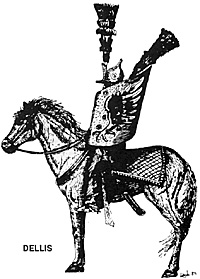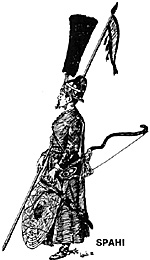
Ottoman Irregular Forces
Since its inception as an empire, the majority of the Ottoman Army was composed of various feudal, levy and auxiliary hosts. The multitude of troop types and terminology was as colorful and diversified as the parent empire's composition.
The most important element of these "part-time" soldiers was the feudal hosts, the Timarots. The Timarots owed military service in return for their fiefs granted to them by the Sultan. A large proportion of these fiefs were originally non-hereditary, but as with the Jannissaries this was changing. The Timarots were divided into two main geographic areas and then sub-divided by wealth and position. Timarots were either European (i.e. Balkan), including, but not exclusively Christian Orthodox, particularly in Bulgaria and Rumelia, or Asian. The European Timarots, because of their approximation to a more sophisticated enemy, tended to be more war- like and better armed. The Asian Timarots, as has been mentioned, now comprised a heavy Arab element and were armed primarily with cane lance or spear, shield and bow.
 The wealthier members of the Timarots were known as Spahis, not to be confused with the regular regiments of the Porte. These Spahis were usually armored and formed into large regional "regiments". The poorer landowners and the Spahis tenants were known collectively as Cebeli and formed the bulk of the feudal hosts. They were less well-armored (if at all) and tended to possess the most antiquated weaponry.
The wealthier members of the Timarots were known as Spahis, not to be confused with the regular regiments of the Porte. These Spahis were usually armored and formed into large regional "regiments". The poorer landowners and the Spahis tenants were known collectively as Cebeli and formed the bulk of the feudal hosts. They were less well-armored (if at all) and tended to possess the most antiquated weaponry.
The next major grouping was the Serhadd Kulu. These were the Azabs and Akinjis who volunteered to fight a particular campaign for loot, but also at this time for pay. The infantry were raised from local garrisons and included the Seymen as peasant dragoons. The cavalry included the Beslis, bow-armed cavalry of the Balkans, and other similar troops known by a variety of names. The military value of such soldiers was minimal and they tended to be used as a labor force for seige works, etc.
Maintained by the lacal garrisons' commanders were the Yerli Kulu or "local troops". These included the Gonullu (volunteers), fierce heavy cavalry, fusileers and local artillerists and pioneers.
Last were the various tributory nations: the Tartars, Romanians, Cossacks and Hungarian rebels. Their contribution was negligible, with the possible exception of the Tartars, whose atrocities represented a certain moral deficit for the Christians. The Tartars were also used to spearhead attacks across rivers, swimming their horses across to gain a foothold. The Hungarians were cavalry and infantry, but though they fought for liberty, it was at the cost of alliance with the infidel, thus losing valuable political support among the local population.
Also to be considered are the local guard troops raised by the Beys and Pashas, the Dellis and Arnauts. The Dellis were bizarrely attired mounted frontier guards. They were armed with lance, sword, bow and some pistols. Their fierceness and recklessness made them particularly valuable as local guard troops for Beys and garrison commanders. They were excellent riders and could serve as scouts against the Christian lands.
The Arnauts were raised from the Balkan population of Albania and Macedonia. They were valued as marksmen and by this date a small minority could have been armed with flintlocks. They wore skull caps and were costumed in a similar fashion to the Croats. The Arnauts were well-versed in swordsmanship and the could additionally be armed with a brace of pistols. At the battle of the Kanlengerb, they served as the Grand Vizier's guard, not breaking into a rout until their position had been overrun and the rest of the army put to flight.
More Ottoman Army at Vienna
-
Ottoman Army at Vienna Part 1: Introduction
Ottoman Army at Vienna Part 1: Army Organization
Ottoman Army at Vienna Part 2: Standards and Flags
Ottoman Army at Vienna Part 2: Irregular Forces
Ottoman Army at Vienna Part 2: Christian Foe
Ottoman Army at Vienna Part 2: WRG Army List
Related
-
Turkish Delights: Using the Ottoman Turks in the Napoleonic Period 1795-1815
Using Ottoman Turks on the Wargame Table
Back to Table of Contents -- Courier Vol. III #4
To Courier List of Issues
To MagWeb Master Magazine List
© Copyright 1982 by The Courier Publishing Company.
This article appears in MagWeb (Magazine Web) on the Internet World Wide Web.
Other military history articles and gaming articles are available at http://www.magweb.com